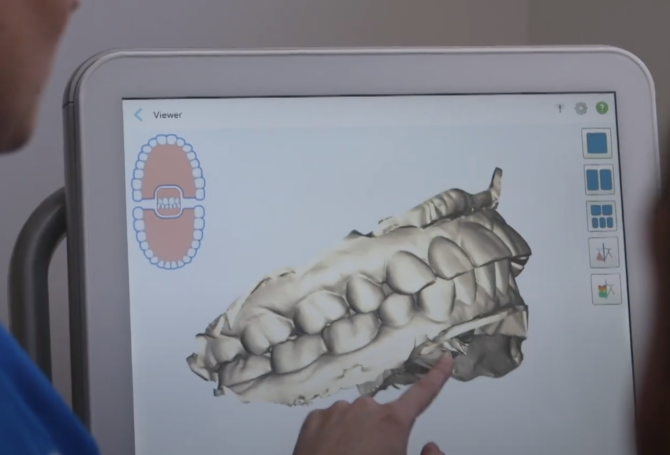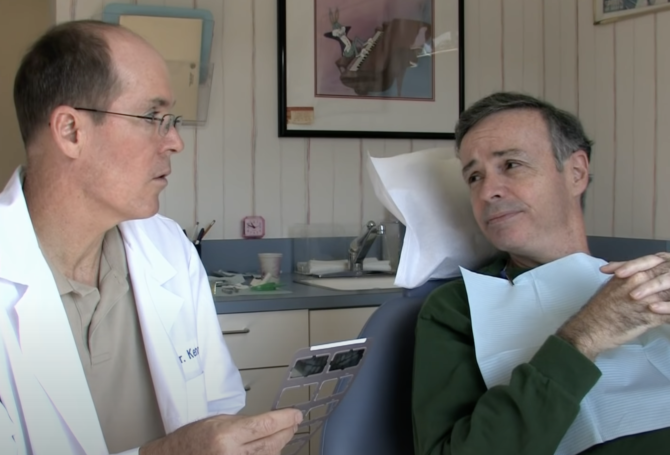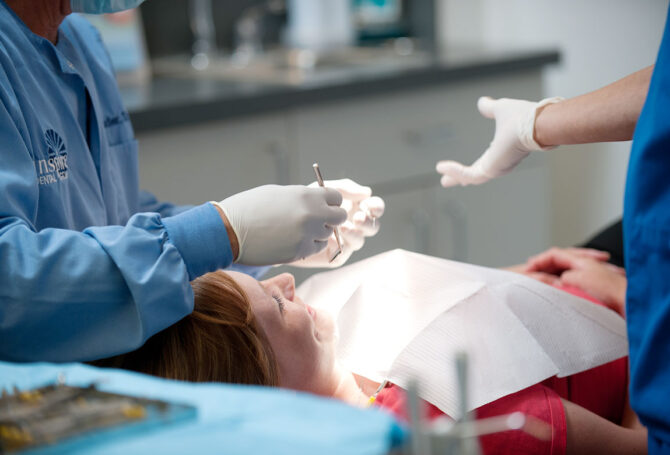Periodontics is a dental specialty that treats the structures supporting the teeth, including gums, bones, and other soft tissue. At Inspire Dental we have a team of dentists and hygienists who are specially trained to provide this unique care to our patients, and work with our general dentists to identify and care for issues as early as possible for better outcomes.
Periodontal care includes treatment and special cleanings for gum disease, structural correction to treat receding gums or repair connective tissue, treatment for bleeding gums, cosmetic adjustments to the gums, and comprehensive plans to treat and prevent bone loss.
Our providers will collaborate to create a custom treatment plan based on the patient’s individual needs.
Do we accept your insurance? Learn more
Frequently Asked Questions
What causes gum disease?
The primary cause of gum disease is plaque; however, other factors can contribute to periodontal disease. These include:
- Hormonal changes – gums tend to get more sensitive, which makes it easier for gingivitis to develop
- Illnesses – may affect the condition of your gums
- Bad habits – such as smoking make it harder for gum tissue to repair itself
- Poor oral hygiene habits – such as not brushing and flossing on a daily basis
- Family history of dental disease
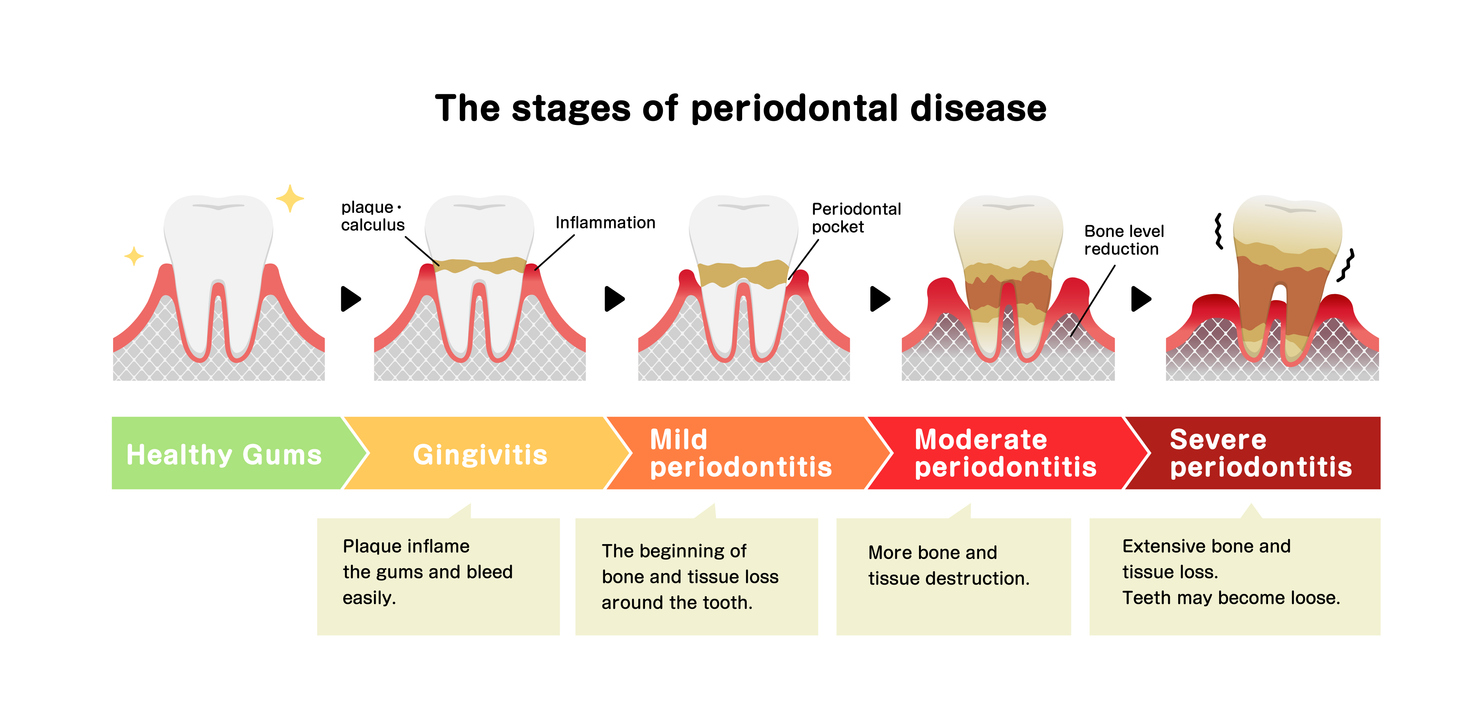
Stages of gum disease:
- Healthy gums and teeth
- Gingivitis – Calculus builds up on teeth and gums are red/enflamed.
- Periodontitis – Inflammation causes gums to separate from tooth, forming pockets. Easy to moderate bone loss.
- Advanced Periodontitis – Severe bone loss, deep pockets. Tooth is in danger of falling out.
Periodontal disease diagnosis:
Diagnosis of periodontal disease includes a thorough examination of dental and medical history of our patients because disease progression can often be linked to one’s systemic health and current dental conditions. During oral examination, we will look for signs of bone loss, gingival bleeding, periodontal probing levels, clinical attachment levels, plaque accumulation, and local contributory factors.
Non-surgical periodontal therapy:
We provide a variety of non-surgical and surgical services. Often times, the early stages of periodontal disease are best treated with non-surgical periodontal therapy. Even in more severe cases, non-surgical treatment often paves the way for surgical therapy. This is done to improve the tissue quality prior to surgery and also to help limit the areas requiring surgery.
The objective of the initial stages of periodontal disease treatment is to remove the plaque and calculus, that lead to disease progression. Treatment involves scaling and root planning, which may be sufficient to manage disease by itself or act complimentary to improve tissue health for further treatment. Scaling is the process of removing plaque, calculus, and strain from the crown and root surfaces, while root planning is the removal of cementum or surface dentin that is rough or infiltrated by toxins and microorganisms.
Treatment is usually performed with specialized hand instruments and ultrasonic scalers that spray and mechanically remove debris from the sites. Antimicrobial agents and rinses, and antibiotics may be indicated for care based on characteristic findings.
Thorough homecare instructions for oral hygiene along with tools including Proxabrushes, toothbrushes, and dental floss will be provided to each patient.
Goals for initial treatment:
- To address systemic conditions that may be contributing to periodontal disease progression.
- To removal the contributing factors (plaque, calculus, toxic bacterial components) allowing for healing of periodontal supporting tissues.
- To create optimal hygiene regiments that can be integrated into one’s current daily routine.
Periodontal surgical treatment:

As periodontal disease progresses it will further affect the surrounding bone and soft tissue creating defects that can no longer be properly managed with non-surgical therapy alone. Surgical treatment will be required to access infected sites for proper debridement. In certain cases, regeneration of bone and soft tissue structures may be possible and can be facilitated by the introduction of regenerative materials including bone grafting materials, growth factors, and biocompatible membranes.
Adjunctive surgical treatments:
Surgical crown lengthening:
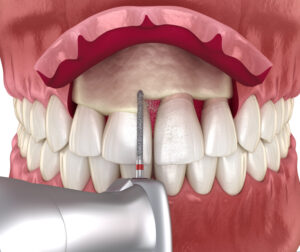 Crown lengthening is a surgical procedure designed to increase the amount of tooth exposed to the oral cavity for esthetic and restorative purposes. Surgical treatment involves reduction of excess gingival tissue and related bone to allow for natural repositioning of the gums in a manner that prevents inflammation related to restoration placement or tooth exposure in an esthetic manner. We will work closely with each patient’s restorative dentist and other related specialists to create a customized treatment option that is tailored to one’s functional and esthetic needs.
Crown lengthening is a surgical procedure designed to increase the amount of tooth exposed to the oral cavity for esthetic and restorative purposes. Surgical treatment involves reduction of excess gingival tissue and related bone to allow for natural repositioning of the gums in a manner that prevents inflammation related to restoration placement or tooth exposure in an esthetic manner. We will work closely with each patient’s restorative dentist and other related specialists to create a customized treatment option that is tailored to one’s functional and esthetic needs.
Management of gingival inflammation:
Gingival inflammation related to systemic, hormonal, medication, and local factors including orthodontic appliances is a common immune response that can lead to oral conditions that are harsh and delay proper maintenance of one’s teeth. We offer multiple surgical and non-surgical treatment options and will work with your other dental and medical care providers to manage these conditions in a thorough manner.
Gingival grafting:
Gingival recession is the result of a loss of tooth supporting hard and soft tissue. This poses an increased risk to the long-term stability of teeth, compromises dental esthetics, and can increase the chances of having root sensitivity and exposure to cavities on the root surfaces. Recession can be caused by various mechanical and local factors that can be magnified by a patient having naturally thin gingival tissue. Gingival grafting can help prevent and halt these negative processes by thickening gingival tissue and covering exposed root surfaces.
Socket preservation:
 When teeth are lost or extracted, bony deficiencies might be noted, which pose a risk for future implant placement and other restorative needs. In these cases, we recommend adjunctive surgical treatment involving bone grafting to aid in space maintenance while promoting bone and soft tissue generation that will allow for stable dental treatment options in the future.
When teeth are lost or extracted, bony deficiencies might be noted, which pose a risk for future implant placement and other restorative needs. In these cases, we recommend adjunctive surgical treatment involving bone grafting to aid in space maintenance while promoting bone and soft tissue generation that will allow for stable dental treatment options in the future.
Bone augmentation:
In cases where teeth have been lost for longer periods of time, bone augmentation may be indicated prior to desired implant planning. This treatment involves thorough planning utilizing cone beam radiographs and digitally directed dental technology to develop a course of treatment suited to a patient’s functional and esthetic desires. To provide adequate bony and soft tissue dimensions, various surgical techniques and materials will be utilized including bone stimulating growth factors, bone graft material, and biocompatible membranes.
Sinus Augmentation:
When considering implant restorative options, having adequate bone available is critical for achieving proper surgical outcomes. In the upper jawbone, the position of the sinus may limit the amount of bone available to place implants. We offer a variety of surgical options involving lifting of the sinus membrane and bone grafting to create space for safe implant placement.
We recognize that periodontal disease is a recurring process that must be properly managed to provide the best outcomes for our patients. Once active disease is stabilized, it is essential to monitor your periodontal condition to prevent further disease progression. Daily brushing and flossing is key to long-term periodontal health, but debris and subsequent bacteria can still accumulate within two months from your last maintenance appointment. Therefore, the periodontal hygiene specialists will develop a maintenance protocol that is tailored to each patient’s needs. Our goal is to remove the stress of disease management and work with you to provide lasting dental outcomes. At Inspire we have a team approach; our patient’s part is to maintain brushing and flossing at home while coming in for your scheduled deep cleanings as well as scaling and root planning. We provide the in office maintenance and monitor your progression.
Periodontal maintenance is a deep cleaning, and you may need these appointments more often. Your hygienist will remove tartar just like with a regular cleaning. They will get in between your teeth and down to your gums (also known as scaling and root planning). In addition, they will examine the pockets of your gums for any infection/inflammation.
Make sure you schedule regular cleanings with your hygienist and if they suggest you have periodontal maintenance done, do not ignore it. This means you have some degree of periodontal disease, and you will need to be seen to get prompt treatment.
Whether you need a regular cleaning or periodontal maintenance, feel free to make an appointment with us.



